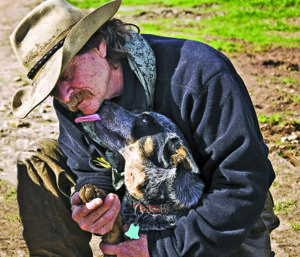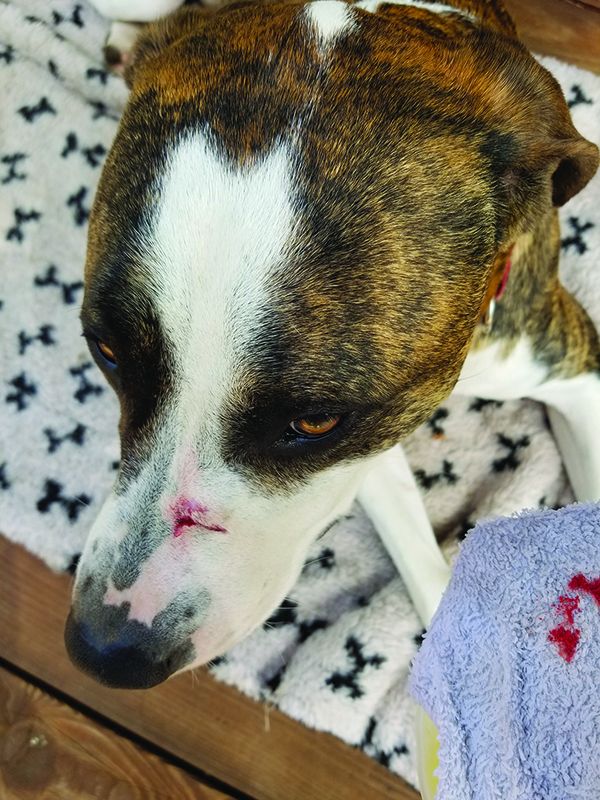It’s a beautiful day and your dog is running, jumping, chasing, playing, and having so much fun that you feel happy all over. What could possibly go wrong? Actually, knowing dogs, all kinds of accidents can happen in the blink of an eye – cuts from broken glass or barbed wire, burned feet from hot pavement, scratches from briars or tree limbs, and more.
While serious injuries require medical attention, many common problems can be treated on the trail or at home. Here are guidelines for dealing with many common minor injuries.
HOME TREATMENT DOG WOUND CARE
Most first-aid instructions for minor wounds involve these three steps:
*Rinse or wash the area, then blot or air dry. Rinse or soak burned paw pads in cool or cold water.
*Apply a first-aid salve or antibiotic ointment.
*If appropriate, bandage the wound for protection. Bandages should not be applied so tightly that they interfere with circulation, and they should be removed after a few hours, whenever wet, or whenever the wound’s dressing is changed.
CLEANING THE DOG WOUND

Photo Credit: Susan Leggett/ Dreamstime.com
Because bacteria are everywhere, reduce the risk of infection by washing, rinsing, or treating the affected area.
WDJ contributor Mary Straus cleans her dogs’ wounds with a blend of witch hazel extract and aloe vera, and lavender oil. “I make my own all-purpose soothing cleanser,” she says, “using 1/4 aloe vera juice or gel and 3/4 witch hazel. I mix it in a 2-ounce dropper bottle, along with a couple of drops of lavender essential oil, and shake it up before using. I’ve been doing this for 20 years and have found that it soothes any itch, and helps keep a dog’s mouth off any wound or abrasion. None of the wounds I’ve used it on became infected. I apply it with cotton balls and let it air dry.”
Witch hazel is rich in tannins – naturally occurring compounds found in plants, seeds, bark, and leaves – which are known to have antimicrobial and anti-inflammatory properties. Look for products with no added fragrance (such as Thayer’s unscented Facial Toner Aloe Vera Formula) and that either contain no alcohol or are low in alcohol, such as Mountain Rose Herbs Witch Hazel Extract, which contains 14% alcohol. (Alcohol can help clean a wound but may sting.)
If you’re a fan of herbal teas, try making an herbal rinse by pouring 1 cup of boiling water over 2 teaspoons or 2 teabags dried herb. Brew larger amounts by pouring 1 quart (4 cups) boiling water over 3 tablespoons or 8 teabags of dried herb. Cover, let the tea steep until cool, strain, refrigerate, and apply as needed. Brewed tea will last up to a week in the refrigerator. If you’re in a hurry, double the amount of herb, brew the tea for 3 minutes, strain, and then dilute and cool it quickly by adding ice.
Herbs known for their skin-healing properties can be purchased from natural markets and herbal tea companies. These include comfrey (Symphytum officinale) leaf and root, German chamomile (Matricaria chamomilla) blossoms, St. John’s wort (Hypericum perforatum) blossoms, calendula (Calendula officinalis) blossoms, broad- or narrow-leaved plantain (Plantago spp.) leaves, and lavender (Lavandula angustifolia) leaves and blossoms.
Comfrey is important for wound healing because it contains allantoin, a cell growth stimulant, but it works so quickly that it should not be applied to sutures that will have to be removed or to puncture wounds in which bacteria might be trapped by rapidly healing skin.
Apple cider vinegar has long been used for first aid. Applied to cuts, wounds, skin infections, and itchy areas, vinegar soothes skin and aids healing. To prevent the staining of white or very light coats, use apple cider vinegar sparingly or substitute distilled white vinegar.
Mineral-rich unrefined sea salt can be added to any tea that will be used to treat wounds. Add 1/8 teaspoon salt per cup of tea. To make an effective spray for any skin disorder, cut, or wound, combine 4 cups of any herbal tea, such as those described above, with 3/4 cup aloe vera juice or gel and 1/2 cup unrefined sea salt.
Even plain salt water is a wound-healing treatment. Years ago in my dog’s obedience class, a female German Shepherd Dog suffered from a sore that wouldn’t heal despite repeated veterinary visits and treatments over several months. When her owner applied a solution of 2 tablespoons unrefined sea salt in 1/2 cup water, the sore improved that same day and healed within a week.
CONTROVERSY ABOUT TOPICAL ANTIBIOTICS
In recent years, concerns have been raised about using topical antibiotic ointments such as Neosporin or other triple antibiotic ointments. Some people worry that these products can contribute to the development of antibiotic-resistant bacteria; others regard the use of products that contain petroleum to be unhealthy.
Neosporin ointment contains bacitracin (400 units), neomycin (3.5 mg), and polymyxin B (5,000 units) in a base of cocoa butter, cottonseed oil, olive oil, sodium pyruvate, vitamin E, and white petrolatum (petroleum jelly). Neosporin Plus (labeled Neosporin + Pain Relief, Maximum Strength Antibiotic) contains bacitracin (500 units), neomycin (3.5 grams), polymyxin B (10,000 units), and pramoxine HCL (10 mg) in a base of white petrolatum.
No published research has shown that bacitracin, neomycin, polymyxin B, or their combination contribute to the spread of antibiotic-resistant bacteria, but it is a popular theory.
In 2018, the journal Infection and Drug Resistance reviewed the use of topical antibiotics for the prevention of uncomplicated wound infections in humans and concluded, “Topical antibiotics are effective in reducing wound infections after surgical procedures, but the absolute benefit is small. Given the global emergence of antimicrobial resistance, judicious use of antibiotics is encouraged and use of antiseptics should be considered as a reasonable alternative to topical antibiotics.”
To use Neosporin, label directions say to cleanse the affected area with soap and water, then dry thoroughly before applying the ointment. Do not apply Neosporin over large skin areas, deep cuts, animal bites, serious burns, or injuries that bleed heavily. Apply one to three times daily, cleaning the wound and, if applicable, using a new bandage each time you apply the ointment. Use Neosporin for as many days as recommended on the label (usually 7) or by your veterinarian, even if symptoms improve sooner.
In a 1989 study comparing dogs recovering from surgery, those treated with Neosporin’s ingredient bacitracin had fewer infections and fewer positive bacteria cultures than those recovering without bacitracin. This ingredient has been approved for use on animals.
Neomycin, another key ingredient, is used to prevent or treat skin infections caused by bacteria. Its topical application is considered safe for dogs.
The ointment’s third antibiotic ingredient, polymyxin B, reinforces Neosporin’s infection-fighting properties in case bacitracin and neomycin are ineffective.
The topical analgesic pramoxine, an ingredient in Neosporin Plus, slightly numbs the skin, which helps relieve pain and prevent irritation and itching. This ingredient, which is considered safe for dogs, appears in anti-itch sprays made for animals.
Neosporin is labeled for external use only and should not be ingested, which is why wounds treated with Neosporin should be protected from a dog licking or swallowing the ointment.
ALTERNATIVE DOG WOUND DRESSINGS
Those who prefer not to use Neosporin or other products with the same ingredients, which are widely sold under various brand names, have many alternative choices.
Once the wound is clean and dry, apply a layer of protection. The following products are widely sold in retail stores, pet supply stores, and online. Note that several are sticky or greasy, so protecting the wound with gauze or a bandage can help prevent stains on fabric, floors, and furniture. Be sure to replace bandages as recommended in product label directions.
*Aquaphor is another topical agent in a petrolatum base. It also contains mineral oil, ceresin (a naturally derived wax used as a thickening agent), lanolin alcohol, panthenol (a moisturizing B vitamin), glycerin, and bisabolol, an ingredient that gives chamomile its anti-inflammatory action. Aquaphor is available in major chain stores such as Target, CVS, Walgreens, Walmart, and more.
In a 2011 study published in the Journal of the American Academy of Dermatology, researchers compared wound-care treatments to learn whether antibiotic-based ointments improve outcomes. They concluded that the petrolatum-based skin protectant ointment Aquaphor from Eucerin provided the same efficacy for wound healing as a combination antibiotic ointment.
Straus began using Aquaphor when her dermatologist recommended it to treat an abrasion, saying that it was better for the skin than an antibiotic ointment. “It’s also fine to use on dogs,” she adds.
*Pet Magic Wound Care from The Honey Collection contains medical-grade Manuka honey (used by medical professionals for its antimicrobial properties), wheatgerm, chamomile, calendula, carrot, and beeswax in a pH-balanced cream. Apply with or without a dressing or bandage. This product is made in New Zealand and available from Amazon.com and Walmart.com.
*Absorbine Silver Honey Rapid Wound Repair Ointment from W.F. Young, Inc., combines medical-grade Manuka honey with micro-sized silver particles that, according to the manufacturer, out-perform colloidal or chelated silver in antimicrobial action. Additional ingredients (there are several) include shea butter and calendula flower extract. Silver Honey Hot Spot & Wound Care Spray Gel provides a hands-free application of the same ingredients to larger areas. See absorbine.com for a list of online and brick-and-mortar retail outlets.
*Restore Wound Care and Itch Relief Salve from Farm Dog Naturals contains cherry kernel, rose hip, almond, apricot kernel, pumpkin seed, karanja, and neem oils along with cancililia wax, unrefined shea butter, and essential oils. To use, apply generous amounts and let stand for 6 to 8 hours, then gently wipe the area with gauze and reapply. For more information, see farmdognaturals.com.
*HoneyCure Natural Veterinary Ointment from Enbiologics combines a natural gelling agent with medical grade Manuka honey, Simmondsia Chinensis (jojoba) oil, and Melaleuca alternifolia (tea tree) oil. Recommended for scrapes, cuts, burns, rashes, and hot spots, this product claims to prevent dogs from licking, biting, and scratching the affected area. See gethoneycure.com.
*Pitch from coniferous trees, which has antibacterial, antiviral, and antifungal properties, is a centuries-old all-purpose healing remedy. In the 1970s, a retired logger founded the North American Tree Resin Company, supplying medicinal pitch from Pacific Douglas fir, yellow pine, and other conifers. Now known as Pruitt’s Tree Resin (themiraclesalve.com), the company’s product line includes a salve for pets made of resin in a base of petroleum jelly. Apply small amounts as needed, avoiding the eyes and mucous membranes.
*EMT Gel from the Hymed Group, a medical hydrolysate Type I collagen product, acts as a tissue adhesive, reduces scarring, forms a semi-occlusive barrier that protects the wound, and conforms to any wound site.
Unlike other first-aid products, EMT Gel can often stop serious bleeding. See hymed.com for more information.
*Collasate, another veterinary hydrolysate of Type I collagen from the Hymed Group (hymed.com), is available as a post-operative gel, spray, or silver-infused topical dressing. It’s recommended for surgical wounds, traumatic and superficial wounds, first- and second-degree burns, foot pad injuries, hot spots, and lick granulomas.
Minor wounds can be inconvenient, and if left untreated they can become serious problems. By knowing how to respond to your pup’s minor injuries, you can avoid complications and enjoy many more carefree outings with your best friend.





